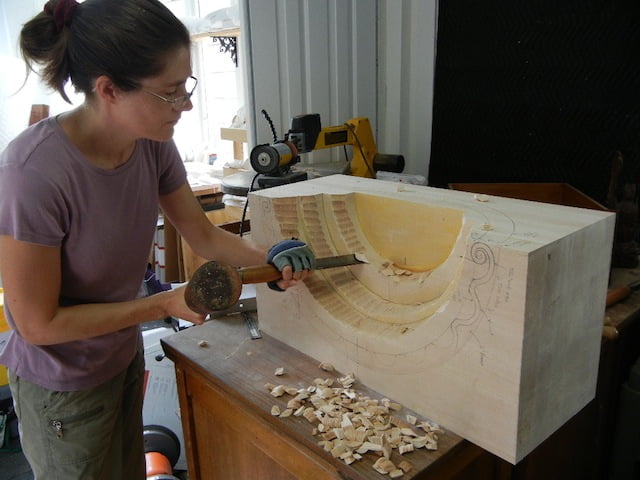Section on Different Types of Joints
Different types of joints in carpentry include the butt joint, rabbet joint, dowel joint, dovetail joint, miter joint and mortise and tenon joint. Each of these joints can be applied in different circumstances for different materials to create a structurally sound end result.
The butt joint is usually used for quickly connecting pieces that don’t need to sustain much weight or pressure. It is created by simply joining two pieces at their ends and can be secured with nails or screws. Dowel joints are another simple solution which uses dowels placed into holes drilled into both pieces in order to keep them connected.
Rabbet joints involve creating notches on the side of one piece in order to fit (cut out) the other piece precisely within. This type of join works particularly well where you have two surfaces which require joining together flush against each other such as cabinet backs and sides or picture frames.
Dovetail joints are perhaps one of the oldest carpentry techniques known to man and provide incredibly strong joinery due to their interlocking shape. It involves intricately cutting out a series of pins from one piece which neatly slots into similarly cut tailpieces from the other part making it practically impossible for them to come apart once put together.
Miter joints are typically used in situations when two pieces at an angle (45-degree angles is most common) must be connected such as when building picture frames or skirting boards around a room. mortise and tenon joints are pretty similar in that they also join two parts together but rely on an insert being made in one piece which locks perfectly into an extended part on the second piece known as the tenon creating a very secure connection.
Introduction to Woodworking Tools and Materials
When it comes to woodworking, one of the most important components is having the right tools and materials at your disposal. To properly start your project, you’ll need a variety of materials such as lumber, screws, nails, sandpaper, glue, paint or varnish, etc. It is important to be aware that different types of wood will require different tools in order to work with them effectively. For example, softwoods will generally require sanding and finishing before they can be used while hardwoods won’t need as much preparation and treatment.
In terms of tools required for woodworking projects, each project will require different tools depending on its scope but certain common power and hand tools can be used for most projects. These include saws (table saws, circular saws), hammers and nail guns, chisels and gouges/planes/hand-cutting techniques, routers/drills/sanders/grinders or shapers/planers. Additionally power drills are essential for drilling holes into woods for screws and nails.
The purchasing process when looking into buying the necessary tools involved in woodworking will depend heavily on budgeting considerations; industry-grade tools are usually more expensive whereas home versions are more affordable but often less reliable or accurate than the professional grade versions. Regardless of budget constraints however it is still highly recommended to spend additional money on quality pieces which can last longer and provide better results than cheaper models with lower performance capabilities in the long run. Aside from this when comparing prices between stores it may be beneficial to look at reviews about both store’s customer service so you feel assured about service delivery after purchase too.
Troubleshooting Common Issues
When working with wood, it is not uncommon to experience issues during the project. Common issues include improper cutting technique, splitting or chipping of the wood, and working with grain that is too hard or soft. Below are some troubleshooting tips to help make sure the project goes as smoothly as possible:
• If you are having trouble making clean cuts with your tools, experiment with different angles (or bevels) to optimize the results. Check if your tools need sharpening or lubrication before use.
• When dealing with splitting or chipping of the wood, always use caution when handling pieces of wood along their edges or grain; burring tool bits are good for beveling end grain and preventing this issue from occurring.
• Different types of wood will require varying levels of sanding and finishing to get a uniform look; hardwood will require additional grit levels than softer woods like pine and oak. Always use protection such as gloves and masks when applying finishes for added safety.
• For difficult grains (i.e., knotty pine), carefully plane the grain pattern in one direction at a time instead of against it; if you plane against its curve, it can cause unsightly indentations on the surface instead.
Maintenance and Care Of Woodworking Tools
Regular cleaning and maintenance of your woodworking tools is essential for a long-lasting and efficient operation. Cleaning should include wiping down the tool with a mild lubricant or solvent, such as mineral spirits, to remove any dirt, dust, or debris. Keeping any moving parts properly oiled will ensure smooth functionality and reduce wear on the tool. Depending on what type of tool you are using, you may need to sharpen blades by hand or invest in a sharpening system. Lastly, check for any worn out parts that need replacing regularly; often times tools can be repaired cheaply and parts salvaged from other machines. If repair becomes costly or regular upgrades are necessary, it likely means it’s time to replace your woodworking machine with a new model. The pros and cons of various brands and models should be researched thoroughly before making this decision.
Adding Details and Decorative Elements
This could include procedures such as coloring, engraving and carving designs into the wood, along with techniques to create specialized finishes like antiquing or glazes. Other methods may include inlaying various materials like brass or stone into the wooden surface, dyeing different pieces of wood to create a patterned accent, or incorporating found objects into functional pieces like furniture. Finally, additional advice can be given on how to apply decorative hardware such as hinges, pulls and handles for added functionality as well as visual appeal.

Hi everyone! I’m a woodworker and blogger, and this is my woodworking blog. In my blog, I share tips and tricks for woodworkers of all skill levels, as well as project ideas that you can try yourself.





